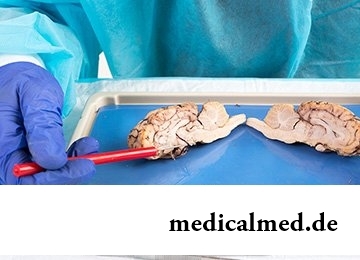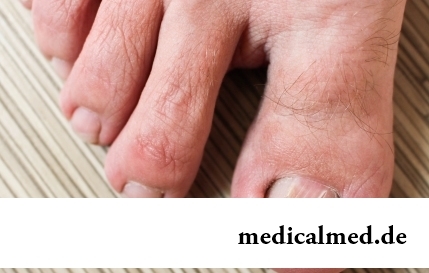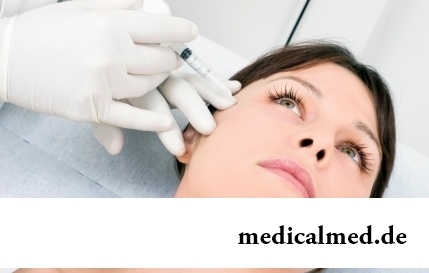





Empty Turkish saddle
 The education in the form of deepening forming in a body of a wedge-shaped bone of a skull of the person is called the Turkish saddle. The state at which there is cavity invagination between soft and web covers of a brain to the intrasellyarny area and is squeezed a hypophysis, caused by insufficiency of a diaphragm of a wedge-shaped bone, call the empty Turkish saddle (ETS).
The education in the form of deepening forming in a body of a wedge-shaped bone of a skull of the person is called the Turkish saddle. The state at which there is cavity invagination between soft and web covers of a brain to the intrasellyarny area and is squeezed a hypophysis, caused by insufficiency of a diaphragm of a wedge-shaped bone, call the empty Turkish saddle (ETS).
This defeat can be primary if it is caused by physiological processes, or secondary when it is found after radiation of hiazmalno-sellyarny area or an operative measure. At a secondary empty Turkish saddle of a brain the diaphragm of the deepening can be not broken.
For the first time the term PTS was offered by the pathologist V. Bush in 1951 when he studied autopsiyny material of the died 788 people and found out that diseases which led to a lethal outcome were not always connected with hypophysis pathology.
The pathologist revealed almost total absence of a diaphragm of the Turkish saddle in 40 cases, instead there was on day of education a hypophysis rasplyvaniye by the form reminding a thin layer of fabric. Then Bush offered classification of the forms of a syndrome, depending on type of a structure of a diaphragm and volume located between a medulla and a cerebellum of intrasellyarny tanks which only in 1995 was modified by T. F. Savostyanov.
Preferential the syndrome of the forming empty Turkish saddle comes to light at the multigiving birth women aged 40 years are more senior (in 80% of cases), nearly 75% of patients have obesity.
Can act as causes of illness a climax, hyper - and a hypothyroidism, pregnancy and a syndrome of a galactorrhoea amenorrhea.
Symptoms of an empty Turkish saddle
In most cases the state proceeds asymptomatically, 70% of patients have a severe headache because of what there is a need for a skull X-ray analysis by means of which the empty Turkish saddle of a brain is found.
Possible manifestation of a syndrome is decrease in visual acuity, a bitemporal hemianopsia and narrowing of peripheral fields. In medical literature the description of hypostasis of an optic nerve even more often meets at PTS.
The forming empty Turkish saddle is found in the increasing number of patients in combination with hypersecretion of tropny hormones and adenoma of a hypophysis.
Under the influence of a pulsation of cerebrospinal fluid in rare instances there is a rupture of a bottom of the Turkish saddle which consequence the rare complication – a rhinorrhea is, demanding immediate surgical intervention. Against the background of a syndrome of an empty Turkish saddle there is a communication between a sphenoidal sine and a suprasellyarny subarachnoid space that considerably increases risk of development of meningitis.
Endocrine disturbances which manifestations are changes of tropny functions of a hypophysis can act as symptoms of an empty Turkish saddle.
According to the researches conducted earlier at which radio immune methods and stimulation tests were used the high percent of patients with subclinical forms of disturbance of secretion of hormones was revealed.
So at 8 of 13 patients the response of secretion of a growth hormone to stimulation was lowered by an insulin hypoglycemia, and at 2 of 16 patients inadequate changes of the adrenocorticotropic hormone which is a stimulator of bark of adrenal glands were revealed.
Also symptoms of an empty Turkish saddle are the increase in peptide hormone of prolactin, motivational and emotional and personal frustration, vegetative disturbances accompanied with a fever, a headache without accurate localization, sharp increase in the ABP and temperature, a cardialgia, faints, extremity and stomach pains, an asthma and emergence at sick sensation of fear.
Development of a liquorrhea, memory impairment, frustration of a chair, breath difficulty, pain in heart, bystry fatigue and decrease in working capacity is not excluded.
Diagnosis of an empty Turkish saddle
Exclusive importance for diagnosis and the subsequent tactics of treatment of an empty Turkish saddle is played by ophthalmologic inspection. At identification of threat of total loss of sight the patient needs urgent surgical intervention.
Laboratory researches by means of which the level of hormones of a hypophysis in a blood plasma is defined are not less important. Also the survey roentgenogram and an aim x-ray film of area of the Turkish saddle, head MPT and KT is necessary for diagnosis of a disease.
Prevention and treatment of an empty Turkish saddle
The measures directed to prevention of a disease include:
- Avoidance of injury-causing situations, developing of thromboses, tumors of a hypophysis and brain;
- Treatment in full inflammatory, including pre-natal, diseases.
At detection at the patient of primary syndrome of PTS treatment is usually not appointed, the main task of the doctor is to convince the patient that the disease is absolutely safe. Replacement hormonal therapy whereas at a secondary empty Turkish saddle it is necessary in each case is in certain cases necessary.
 Surgical intervention at primary syndrome of PTS is shown only in two cases, namely:
Surgical intervention at primary syndrome of PTS is shown only in two cases, namely:
- When sagging in an opening of a diaphragm of the Turkish saddle of the visual intersection because of what there is a disturbance of fields and a prelum of nerves of sight;
- At the expiration from a nose of cerebrospinal fluid through the pierced bottom of the Turkish saddle;
At a secondary syndrome of an empty Turkish saddle the neurosurgeon, depending on indications, can appoint treatment of a tumor of a hypophysis.
Empty Turkish saddle call a state at which the hypophysis is squeezed and there is cavity invagination between soft and web covers of a brain to the intrasellyarny area. According to statistical data, the disease develops against the background of obesity, a climax, pregnancy, hyper - and a hypothyroidism. Treatment of primary and secondary syndrome is appointed by the neurosurgeon in an individual order, depending on indications.
The first vibrator was invented in the 19th century. It worked at the steam engine and intended for treatment of female hysteria.

The word "onikhokriptoz" is unfamiliar to most of people, meanwhile quite so physicians call very widespread problem: growing...
Section: Articles about health
Producers of milk mixes for children assure: mixes are ideally balanced and adapted for needs of babies. If mother should raise artificially the kid owing to serious problems with health, to do nothing – m substitutes...
Section: Articles about health
Smoking not only exerts a negative impact on the state of health of the consumer of tobacco products, but is an air polluter the substances potentially dangerous to people around. In recent years significantly the number of the people aiming to get rid of an addiction increased. Business this difficult: having left off smoking, the person immediately begins to suffer from abstinence. Besides, many yesterday's smokers feel at first great disappointment as улучш...
Section: Articles about health
For the time being the perspective of heart diseases seems to most of people remote and foggy. But sooner or later практичес...
Section: Articles about health
All diseases from nerves – in this joke a big element of truth, are said by doctors. Constant stresses lead to decrease in protective forces of an organism, and it becomes vulnerable for a set of diseases. It is wrong to think that the stress is a problem of the present. Life of people and hundred...
Section: Articles about health
We present to yours the TOP of the medicamentous means exerting the stimulating impact on a potentiality, i.e. on ability of the man to commission of sexual intercourse. At once it is necessary to tell that not always disturbances of erectile function can be eliminated with reception of this or that drug. The reasons of decrease in a potentiality there can be a set, from banal overfatigue before tumoral process in a small basin therefore if the man faces similar problems too often, it should turn...
Section: Articles about health
For the help to doctors in the choice of optimal solutions for treatment of various diseases the Cochrane scientific organization (Cochrane) will see off совм...
Section: Articles about health
One of the major chemical processes happening in a human body are oxidation reactions. They go with participation of fats and carbohydrates which we receive from food, and the oxygen getting to us from air. A main goal of such reactions is it is received...
Section: Articles about health
Vitamin complexes belong to the most popular drugs, probably, in our country there is no person who was not hearing about advantage of vitamins and never their accepting. The more vitamins, the better, we consider and as it appeared, cruelly we are mistaken. Whether vitamins, whether so harmlessly general hobby for polyvitaminic complexes and whether it is possible to do without them are so useful? Let's try to understand....
Section: Articles about health
Partial and the more so full loss of hearing significantly reduces quality of life. Difficulties with communication lead to loneliness and замкн...
Section: Articles about health
With age in a human body harmful substances collect. We receive them with food and water, at inhalation of the contaminated air, reception of medicines, use of household chemicals and cosmetics. A considerable part of toxins accumulates in a liver, osnovno...
Section: Articles about health
Diseases of joints often begin imperceptibly for the person. The first stages of destruction of the cartilaginous tissue providing soft and free sliding of heads of bones in joint bags proceed slowly and absolutely without serious consequences. Especially unpleasantly for the fact that this process is not connected with advanced age: degradation of joint surfaces is, as a rule, noticeable after 30 years. It means that practically each able-bodied person at any time can face sad results...
Section: Articles about health
The state of health of the person in many respects depends on food. The organism will well function if during food it are...
Section: Articles about health
The list of stereotypes of which, apparently, all know strongly includes following: British surely eat porridge for breakfast. Perhaps, not all modern residents of Britain arrive quite so, but for those from them which continue to follow this t...
Section: Articles about health
Among a set of the perfumery and cosmetic goods which are released today the special group is made by the means containing antibacterial components. Such types of gels, shampoos, soaps, creams, lotions and other products are positioned by manufacturers as a panacea from all diseases caused by pathogenic microorganisms. The unlimited and uncontrolled use of similar means becomes result of trustfulness of the buyers hypnotized by persuasive advertizing sometimes. Many spetsial...
Section: Articles about health
Bulimia and anorexia, are heavy deviations of a feeding behavior, become a cause of death of patients much more often than all others...
Section: Articles about health
EKO, or extracorporal fertilization - a method of treatment of infertility which became the reason of a set of broken-down copies in due time accused the people working on its creation neither more nor less of rivalry good luck. Already very few people deny the rights...
Section: Articles about health
Obesity is called a disease of 21 centuries, for the last 100 years the number of the people suffering from excess body weight considerably increased. Statistically, on Earth already about 1,5 billion corpulent people, and 500 million from them have the extreme degree of completeness negatively affecting quality and duration of their life. What served as the reason of growth of stout persons on the planet? How not to get to their ranks? Let's consider five main premises for increase in body weight in conditions современнос...
Section: Articles about health
Maternal milk is the best food for the newborn. It is the unique natural product containing optimum set...
Section: Articles about health
History of cultivation of a buckwheat contains more than five thousand years. Grain which is received from this plant is used for preparation of porridges, soups, baked puddings and puddings, do flour which is one of the main ingredients of the noodles popular in of it...
Section: Articles about health
Coffee – favourite drink of many. For the last decades it more than once already declared very harmful, extremely useful and even necessary for normal life activity. In spite of the fact that this product became for us usual for a long time, there are many myths about properties of coffee and its impact on a human body. Readers can get acquainted with the most widespread of similar delusions today....
Section: Articles about health
All the known slogan "Protect Men!" arose not from scratch. In a sense, the nature created representatives of strong...
Section: Articles about health
About influence of fasting days on an organism it is told much – both about advantages, and about shortcomings. It is considered that fasting day in the form of a short-term monodiet is useful, promoting effective removal of slags from an organism whereas irregular, it is excessive п...
Section: Articles about health
The business lady, the become mother, it is necessary to solve an array of problems. But of them is main: how to combine the beloved child and work? What traps trap the working mother and how she needs to behave?...
Section: Slideshow
Some people consider what for medicine of the 21st century of secrets in the field of health of the person almost does not exist. It absolutely not so. Than Bol...
Section: Articles about health
Eyes – unique body on the structure thanks to which the person obtains about 80% of information on the world around: about a form, color, size, the movement, and also many other parameters of objects or phenomena. But whether much we know about the most valuable body...
Section: Articles about health
Antibiotics - - it is possible to call the chemical compounds suppressing growth of bacteria the break in the field of medicine which allowed to save mankind from many diseases incurable earlier: tuberculosis, plague, syphilis and many others. The contribution of drugs to rescue of people from epidemics of dangerous infections is huge, however at careless use antibiotics are capable to cause to an organism serious damage. Negative action can be shown in the form of easing of immunity, disturbance of balance of microflora in кишеч...
Section: Articles about health
